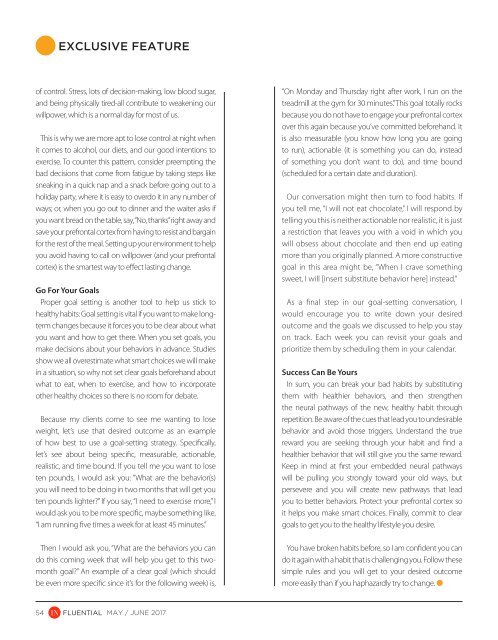InFluential_Magazine_May_June_2017
You also want an ePaper? Increase the reach of your titles
YUMPU automatically turns print PDFs into web optimized ePapers that Google loves.
EXCLUSIVE FEATURE<br />
of control. Stress, lots of decision-making, low blood sugar,<br />
and being physically tired-all contribute to weakening our<br />
willpower, which is a normal day for most of us.<br />
This is why we are more apt to lose control at night when<br />
it comes to alcohol, our diets, and our good intentions to<br />
exercise. To counter this pattern, consider preempting the<br />
bad decisions that come from fatigue by taking steps like<br />
sneaking in a quick nap and a snack before going out to a<br />
holiday party, where it is easy to overdo it in any number of<br />
ways; or, when you go out to dinner and the waiter asks if<br />
you want bread on the table, say, “No, thanks” right away and<br />
save your prefrontal cortex from having to resist and bargain<br />
for the rest of the meal. Setting up your environment to help<br />
you avoid having to call on willpower (and your prefrontal<br />
cortex) is the smartest way to effect lasting change.<br />
Go For Your Goals<br />
Proper goal setting is another tool to help us stick to<br />
healthy habits: Goal setting is vital if you want to make longterm<br />
changes because it forces you to be clear about what<br />
you want and how to get there. When you set goals, you<br />
make decisions about your behaviors in advance. Studies<br />
show we all overestimate what smart choices we will make<br />
in a situation, so why not set clear goals beforehand about<br />
what to eat, when to exercise, and how to incorporate<br />
other healthy choices so there is no room for debate.<br />
Because my clients come to see me wanting to lose<br />
weight, let’s use that desired outcome as an example<br />
of how best to use a goal-setting strategy. Specifically,<br />
let’s see about being specific, measurable, actionable,<br />
realistic, and time bound. If you tell me you want to lose<br />
ten pounds, I would ask you: “What are the behavior(s)<br />
you will need to be doing in two months that will get you<br />
ten pounds lighter?” If you say, “I need to exercise more,” I<br />
would ask you to be more specific, maybe something like,<br />
“I am running five times a week for at least 45 minutes.”<br />
Then I would ask you, “What are the behaviors you can<br />
do this coming week that will help you get to this twomonth<br />
goal?” An example of a clear goal (which should<br />
be even more specific since it’s for the following week) is,<br />
“On Monday and Thursday right after work, I run on the<br />
treadmill at the gym for 30 minutes.” This goal totally rocks<br />
because you do not have to engage your prefrontal cortex<br />
over this again because you’ve committed beforehand. It<br />
is also measurable (you know how long you are going<br />
to run), actionable (it is something you can do, instead<br />
of something you don’t want to do), and time bound<br />
(scheduled for a certain date and duration).<br />
Our conversation might then turn to food habits. If<br />
you tell me, “I will not eat chocolate,” I will respond by<br />
telling you this is neither actionable nor realistic, it is just<br />
a restriction that leaves you with a void in which you<br />
will obsess about chocolate and then end up eating<br />
more than you originally planned. A more constructive<br />
goal in this area might be, “When I crave something<br />
sweet, I will [insert substitute behavior here] instead.”<br />
As a final step in our goal-setting conversation, I<br />
would encourage you to write down your desired<br />
outcome and the goals we discussed to help you stay<br />
on track. Each week you can revisit your goals and<br />
prioritize them by scheduling them in your calendar.<br />
Success Can Be Yours<br />
In sum, you can break your bad habits by substituting<br />
them with healthier behaviors, and then strengthen<br />
the neural pathways of the new, healthy habit through<br />
repetition. Be aware of the cues that lead you to undesirable<br />
behavior and avoid those triggers. Understand the true<br />
reward you are seeking through your habit and find a<br />
healthier behavior that will still give you the same reward.<br />
Keep in mind at first your embedded neural pathways<br />
will be pulling you strongly toward your old ways, but<br />
persevere and you will create new pathways that lead<br />
you to better behaviors. Protect your prefrontal cortex so<br />
it helps you make smart choices. Finally, commit to clear<br />
goals to get you to the healthy lifestyle you desire.<br />
You have broken habits before, so I am confident you can<br />
do it again with a habit that is challenging you. Follow these<br />
simple rules and you will get to your desired outcome<br />
more easily than if you haphazardly try to change. l<br />
54 FLUENTIAL MAY / JUNE <strong>2017</strong>


















